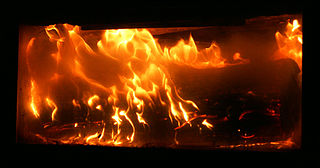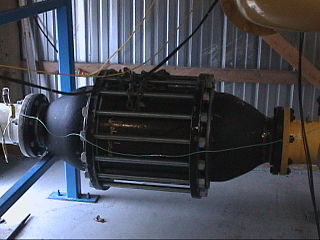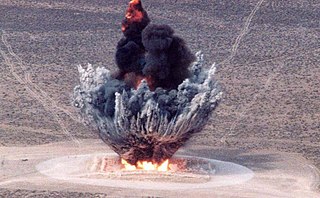The Shchelkin spiral is a device that assists the transition from deflagration (subsonic combustion) to detonation in a pulse detonation engine. The spiral is named after Kirill Ivanovich Shchelkin, a Russian physicist who described it in his 1965 book Gas Dynamics of Combustion. [1]

Deflagration is subsonic combustion propagating through heat transfer; hot burning material heats the next layer of cold material and ignites it. Most "fires" found in daily life, from flames to explosions such as that of Black powder, are deflagrations. This differs from detonation, which propagates supersonically through shock waves, decomposing a substance extremely quickly.

Detonation is a type of combustion involving a supersonic exothermic front accelerating through a medium that eventually drives a shock front propagating directly in front of it. Detonations occur in both conventional solid and liquid explosives, as well as in reactive gases. The velocity of detonation in solid and liquid explosives is much higher than that in gaseous ones, which allows the wave system to be observed with greater detail.
A pulse detonation engine (PDE) is a type of propulsion system that uses detonation waves to combust the fuel and oxidizer mixture. The engine is pulsed because the mixture must be renewed in the combustion chamber between each detonation wave and the next. Theoretically, a PDE can operate from subsonic up to a hypersonic flight speed of roughly Mach 5. An ideal PDE design can have a thermodynamic efficiency higher than other designs like turbojets and turbofans because a detonation wave rapidly compresses the mixture and adds heat at constant volume. Consequently, moving parts like compressor spools are not necessarily required in the engine, which could significantly reduce overall weight and cost. PDEs have been considered for propulsion since 1940. Key issues for further development include fast and efficient mixing of the fuel and oxidizer, the prevention of autoignition, and integration with an inlet and nozzle.
In pulse detonation engines, direct detonation of the combustible mixture can be relatively straightforward, but require more energy than when detonation is preceded by deflagration. The deflagration to detonation transition (DDT) must however occur within the length of the detonation tube, which can be solved by providing the Shchelkin spiral. The Shchelkin spiral acts as an obstacle by creating a partial blockage of the detonation tube, effectively shortening the distance along the detonation tube in which the transition occurs. [2]

A fuel is any material that can be made to react with other substances so that it releases energy as heat energy or to be used for work. The concept was originally applied solely to those materials capable of releasing chemical energy but has since also been applied to other sources of heat energy such as nuclear energy.
Deflagration to detonation transition (DDT) refers to a phenomenon in ignitable mixtures of a flammable gas and air when a sudden transition takes place from a deflagration type of combustion to a detonation type of explosion.







